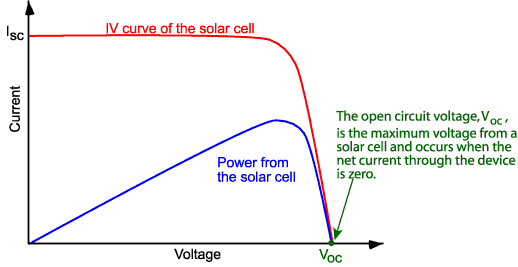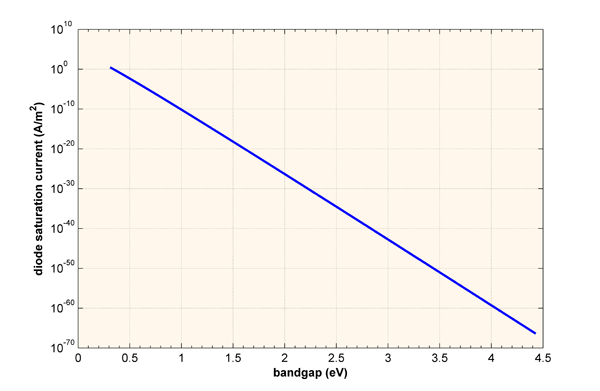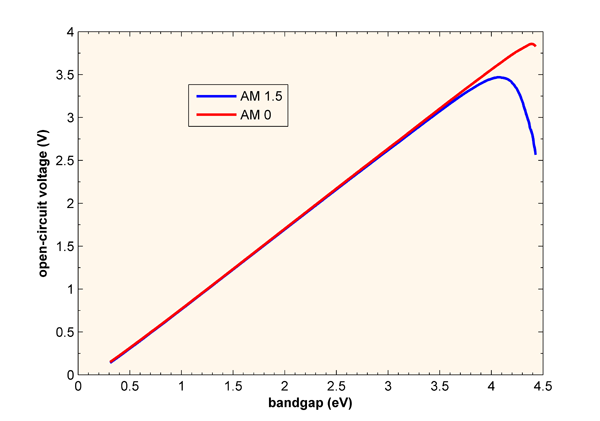The open-circuit voltage, VOC, is the maximum voltage available from a solar cell, and this occurs at zero current. The open-circuit voltage corresponds to the amount of forward bias on the solar cell due to the bias of the solar cell junction with the light-generated current. The open-circuit voltage is shown on the IV curve below.

IV curve of a solar cell showing the open-circuit voltage.
An equation for Voc is found by setting the net current equal to zero in the solar cell equation to give:
$$V_{OC}=\frac{n k T}{q} \ln \left(\frac{I_{L}}{I_{0}}+1\right)$$
A casual inspection of the above equation might indicate that VOC goes up linearly with temperature. However, this is not the case as I0 increases rapidly with temperature primarily due to changes in the intrinsic carrier concentration ni. The effect of temperature is complicated and varies with cell technology. See the page “Effect of Temperature” for more details
VOC decreases with temperature. If temperature changes, I0 also changes.
The above equation shows that Voc depends on the saturation current of the solar cell and the light-generated current. While Isc typically has a small variation, the key effect is the saturation current, since this may vary by orders of magnitude. The saturation current, I0 depends on recombination in the solar cell. Open-circuit voltage is then a measure of the amount of recombination in the device. Silicon solar cells on high quality single crystalline material have open-circuit voltages of up to 764 mV under one sun and AM1.5 conditions1, while commercial silicon devices typically have open-circuit voltages around 690 mV.
The VOC can also be determined from the carrier concentration 2:
$$V_{OC}=\frac{k T}{q} \ln \left[\frac{\left(N_{A}+\Delta n\right) \Delta n}{n_{i}^{2}}\right]$$
where kT/q is the thermal voltage, NA is the doping concentration, Δn is the excess carrier concentration and ni is the intrinsic carrier concentration. The determination of VOC from the carrier concentration is also termed Implied VOC.
Voc as a Function of Bandgap, EG
Where the short-circuit current (ISC) decreases with increasing bandgap, the open-circuit voltage increases as the band gap increases. In an ideal device the VOC is limited by radiative recombination and the analysis uses the principle of detailed balance to determine the minimum possible value for J0.
The minimum value of the diode saturation current is given by 3:
$$J_{0}=\frac{q}{k} \frac{15 \sigma}{\pi^{4}} T^{3} \int_{u}^{\infty} \frac{x^{2}}{e^{x}-1} d x$$,
where q is the electronic charge, σ is the Stefan–Boltzmann constant, k is Boltzmann constant, T is the temperature and
$$u=\frac{E_{G}}{k T}$$
Evaluating the integral in the above equation is quite complex. The graph below uses the method outlined in 4

Diode saturation current as a function of band gap. The values are determined from detailed balance and place a limit on the open circuit voltage of a solar cell.
The J0 calculated above can be directly plugged into the standard solar cell equation given at the top of the page to determine the VOC so long as the voltage is less than the band gap, as is the case under one sun illumination.

VOC as function of bandgap for a cell with AM 0 and AM 1.5. The VOC increases with bandgap as the recombination current falls. There is drop off in VOC at very high band gaps due to the very low ISC.
- 1. “Analysis of the recombination mechanisms of a silicon solar cell with low bandgap-voltage offset”, Journal of Applied Physics, vol 121, 호 20, p 205704, 2017.
- 2. , “Contactless determination of current–voltage characteristics and minority-carrier lifetimes in semiconductors from quasi-steady-state photoconductance data”, Applied Physics Letters, vol 69, pp 2510-2512, 1996.
- 3. , “On some thermodynamic aspects of photovoltaic solar energy conversion”, Solar Energy Materials and Solar Cells, vol 36, pp 201-222, 1995.
- 4. , “Rapid and precise calculations of energy and particle flux for detailed-balance photovoltaic applications”, Solid-State Electronics, vol 50, pp 1400-1405, 2006.
- Log in or register to post comments
- 3 comment(s)
 Español
Español
